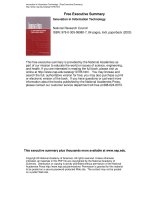the mit press wired for innovation how information technology is reshaping the economy oct 2009
Bạn đang xem bản rút gọn của tài liệu. Xem và tải ngay bản đầy đủ của tài liệu tại đây (683.35 KB, 175 trang )
WIRED
FOR INNOVATION
<i`b9ipeafc]jjfe8[XdJXle[\ij
È
9ipeafc]jjfeXe[JXle[\ij_Xm\ni`kk\eXe`dgfikXekifX[dXg]fi]lkli\k\Z_efcf^p`eefmXk`fe%
8
epfe\`ek\i\jk\[`ek_\Ylj`e\jjXe[\Zfefd`Zjf]`e]fidXk`fek\Z_efcf^pj_flc[i\X[k_`jYffb%É
Ç
:_i`j8e[\ijfe#<[`kfi$`e$:_`\]#N`i\[#Xlk_fif]=i\\1K_\=lkli\f]XIX[`ZXcGi`Z\
?fn@e]fidXk`feK\Z_efcf^p@jI\j_Xg`e^k_\<Zfefdp
Wired for Innovation
Wired for
Innovation
How Information
Technology Is
Reshaping
the Economy
Erik Brynjolfsson and
Adam Saunders
The MIT Press
Cambridge, Massachusetts
London, England
© 2010 Massachusetts Institute of Technology
All rights reserved. No part of this book may be reproduced in any
form by any electronic or mechanical means (including photocopying,
recording, or information storage and retrieval) without permission in
writing from the publisher.
For information about quantity discounts, email specialsales@mitpress
.mit.edu.
Set in Palatino. Printed and bound in the United States of America.
Library of Congress Cataloging-in-Publication Data
Brynjolfsson, Erik.
Wired for innovation : how information technology is reshaping the
economy / Erik Brynjolfsson and Adam Saunders.
p. cm.
Includes bibliographical references and index.
ISBN 978-0-262-01366-6 (hardcover : alk. paper)
1. Technological innovations—Economic aspects. I. Saunders, Adam.
II. Title.
HC79.T4.B79 2009
303.48'33—dc22
2009013165
10 9 8 7 6 5 4 3 2 1
Acknowledgments vii
Introduction ix
1 Technology, Innovation, and Productivity
in the Information Age 1
2 Measuring the Information Economy 15
3 IT’s Contributions to Productivity and
Economic Growth 41
4 Business Practices That Enhance Productivity 61
5 Organizational Capital 77
6 Incentives for Innovation in the Information
Economy 91
7 Consumer Surplus 109
8 Frontier Research Opportunities 117
Contents
vi Contents
Notes 129
Bibliography 135
Index 149
The idea for this book originated in a request by Michael
LoBue of the Institute for Innovation and Information
Productivity for an accessible overview of research and
open issues in the areas of IT innovation and productivity.
With guidance and inspiration from Karen Sobel Lojeski
at the IIIP, and through the IIIP’s research sponsorship of
the MIT Center for Digital Business, we were able to
devote more than a year to studying the main research
results in these areas and to producing a report that even-
tually became this book.
We are also grateful to the National Science Foundation,
which provided partial support for Erik Brynjolfsson
(grant IIS-0085725), and to the other research sponsors of
the MIT Center for Digital Business, including BT, Cisco
Systems, CSK, France Telecom, General Motors, Google,
Hewlett-Packard, Hitachi, Liberty Mutual, McKinsey,
Oracle, SAP, Suruga Bank, and the University of Lecce.
We thank Paul Bethge and Jane Macdonald at the MIT
Acknowledgments
viii Acknowledgments
Press for their editing and for expert assistance with the
publication process. Heekyung Kim, Andrea Meyer, Dana
Meyer, Craig Samuel, and Irina Starikova commented on
drafts of portions of the manuscript.
The ideas, examples, and concepts discussed in the
book were inspired over a period of years by numerous
stimulating conversations with our colleagues at MIT and
in the broader academic and business communities. In
particular, we’d like to thank Masahiro Aozono, Chris
Beveridge, John Chambers, Robert Gordon, Lorin Hitt,
Paul Hofmann, Dale Jorgenson, Henning Kagermann,
David Verrill, and Taku Tamura for sharing insights and
suggestions. Most of all, we would like to thank Martha
Pavlakis and Galit Sarfaty for their steadfast support and
encouragement.
Introduction
The fundamentals of the world economy point to con-
tinued innovation in technology through the booms and
busts of the fi nancial markets and of business investment.
Gordon Moore predicted in 1965 that the number of tran-
sistors that could be placed on a microchip would double
every year. (Later he revised his prediction to every two
years.) That prediction, which became known as Moore’s
Law, has held for four decades. Furthermore, businesses
have not even exploited the full potential of existing tech-
nologies. We contend that even if all technological prog-
ress were to stop tomorrow, businesses could create
decades’ worth of IT-enabled organizational innovation
using only today’s technologies. Although some say that
technology has matured and become commoditized in
business, we see the technological “revolution” as just
beginning. Our reading of the evidence suggests that the
strategic value of technology to businesses is still increas-
ing. For example, since the mid 1990s there has been a
x Introduction
dramatic widening in the disparity in profi ts between the
leading and lagging fi rms in industries that use technol-
ogy intensively (as opposed to producing technology).
Non-IT-intensive industries have not seen a comparable
widening of the performance gap—an indication that
deployment of technology can be an important differen-
tiator of fi rms’ strategies and their degrees of success.
Despite decades of high growth in investment, offi cial
measures of information technology suggest that it still
accounts for a relatively small share of the US economy.
Though roughly half of all investment in equipment by
US businesses is in information-processing equipment
and software (as has been the case since the late 1990s),
less than 2 percent of the economy is dedicated to produc-
ing hardware and software. When the computer systems
design and related services industry is added, as well as
information industries such as publishing, motion picture
and sound recording, broadcasting and telecommunica-
tions, and information and data processing services, the
total value added amounts to less than 7 percent of the
economy. However, when it comes to innovation the
story is quite different: every year in the period 1995–2007,
between 50 percent and 75 percent of venture capital
went into the funding of companies in the IT-production
and information industries. We also see much greater
turbulence and volatility in the information industries,
refl ecting the gale of creative destruction that inevitably
accompanies disruptive innovation. Firms in those indus-
tries have a much higher ratio of intangible assets to
Introduction xi
tangible ones. Because valuing intangibles is diffi cult,
wealth for fi rms in these industries is often created or
destroyed much more rapidly than for fi rms that are in
the business of creating physical goods.
The literature on productivity points to a clear conclu-
sion: information technology has been responsible,
directly or indirectly, for most of the resurgence of pro-
ductivity in the United States since 1995. Before 1995,
decades of investment in information technology seemed
to yield virtually no measurable overall productivity
growth (an effect commonly referred to as the productiv-
ity paradox). After 1995, however, productivity increased
from its long-term growth rate of 1.4 percent per year to
an average of 2.6 percent per year until 2000. But informa-
tion technology wasn’t the sole cause of the increased
growth. A signifi cant body of research fi nds that the
reason technology played a larger role in the acceleration
of productivity in the United States than in other indus-
trialized countries is that American fi rms adopted pro-
ductivity-enhancing business practices along with their IT
investments.
In the period 2001–2003, productivity growth acceler-
ated to 3.6 percent per year, making that the best three-
year period of productivity growth since 1963–1965.
Whereas economists generally agree on the causes of the
1995–2000 productivity surge, there is less consensus in
the literature about the 2001–2003 surge. We attribute
it to the delayed effects of the huge investments in busi-
ness processes that accompanied the large technology
xii Introduction
investments of the late 1990s. The literature suggests that
it can take several years for the full effects of technology
investments on productivity to be realized because of the
resultant redesign of work processes. An ominous impli-
cation of this analysis is that the sharp decline in IT invest-
ment growth rates in 2001–2003 may have been responsible
for the decline in measured productivity growth 3–4 years
later. In 2004–2006, productivity growth averaged only 1.3
percent. However, in 2007 and 2008 productivity growth
nearly returned to its 1996–2000 rate, approximately 2.4
percent per year. If our hypothesis is correct, this may
have been due in part to an increase in investment in IT
that began in 2004.
The companies with the highest returns on their tech-
nology investments did more than just buy technology;
they invested in organizational capital to become digital
organizations. Productivity studies at both the fi rm level
and the establishment (or plant) level during the period
1995–2008 reveal that the fi rms that saw high returns on
their technology investments were the same fi rms that
adopted certain productivity-enhancing business prac-
tices. The literature points to incentive systems, training,
and decentralized decision making as some of the prac-
tices most complementary to technology. Moreover, the
right combinations of these practices are much more impor-
tant than any of the individual practices. Copying any
one practice may not be very diffi cult for a fi rm, but
duplicating a competitor’s success requires replicating a
Introduction xiii
portfolio of interconnecting practices. Upsetting the
balance in a company’s particular combination of labor
and capital investments, even slightly, can have large
consequences for that company’s output and productiv-
ity. As in a fi ne watch, the whole system may fail if even
one small and seemingly unimportant piece is missing or
fl awed.
The unique combination of a fi rm’s practices can be
thought of as a kind of organizational capital. We are
beginning to see in the literature the fi rst attempts to value
this intangible organizational capital, which could be
worth trillions of dollars in the United States alone. Some
researchers use fi nancial markets, some attempt to add up
spending on intangibles, and others use analysts’ earning
estimates to answer a basic question: How large are the
annual investment and the total stock of intangible assets
in the economy? For example, at the start of 2009 Google
was worth approximately $100 billion but had only $5
billion in physical assets and about $18 billion in cash,
investments, and receivables (according to balance-sheet
information and fi nancial-market data for December 31,
2008; total fi nancial value is the sum of market capitaliza-
tion and liabilities). The other $77 billion consisted of
intangible assets that the market values but which are not
directly observable on a balance sheet. Because the litera-
ture is not yet well developed, we expect to see more work
in this area in the coming years. Various researchers have
estimated that the annual investment in these intangibles
xiv Introduction
held by US businesses is at least $1 trillion. A large portion
of it does not show up in offi cial measures of business
investment. We see the attempt to quantify the value of
these intangibles as a major research opportunity.
Producers of information goods face a major upheaval
because of declining communication costs and because of
the ease of replication and reproduction. Never before
has it been so easy to make a perfect and nearly costless
copy of an original information product. The music
industry was one of the fi rst to confront this transforma-
tion and is now going through a major restructuring.
Many other industries will face similar disruption. An
important task will be to improve the intellectual-
property system to maximize total social welfare by
encouraging innovation by producers while allowing as
many people as possible to benefi t from innovation at the
lowest possible price.
Non-market transactions involving information goods
generate signifi cant value in the economy and provide a
promising avenue for research. The total value that con-
sumers get from Google or Yahoo searches is not counted
in any offi cial output statistics, and thus far no academic
research has even attempted to quantify it. The lucrative
business of keyword advertising pays for these searches.
Internet users’ demand for searches feeds the advertising
market at search-engine sites and also drives visitors to
publishers of other content. Highly targeted keyword
advertising then feeds demand back to the advertisers’
Introduction xv
sites. The two sides of the market are mutually reinforc-
ing, which makes keyword searches and keyword adver-
tising an example of information complements. The makers
of information complements may subsidize one side of
the market to promote growth of the other, as in the case
of Adobe giving away its Reader software to enlarge the
market for its PDF-writing Acrobat software. The cumula-
tive value of the free or subsidized halves of these two-
sided markets is potentially enormous, but today we have
no measure for it. And there are other business models—
exemplifi ed by Wikipedia, YouTube, and weblogs—that
generate enormous quantities of free goods and services,
accounting for an increasing share of value, if not dollar
output, in the world economy.
There are no offi cial measures of the value of product
variety or of new goods, but recent research indicates that
this uncounted value to consumers is tremendous. In this
book we examine an additional metric not included in
government accounts as an important method of measur-
ing the effect of technology on the economy. This metric
is consumer surplus. Although the idea of consumer surplus
is more than 150 years old, the use of this methodology
to empirically value the introduction of entirely new
goods or to value changes in the variety, quality, and
timeliness of existing goods is relatively recent. However,
the uncounted value from information goods is simply
too large to ignore, and we need to do a better job of
measuring it.
xvi Introduction
Aspects of the information economy that couldn’t be
measured by traditional methods can now be measured,
analyzed, and managed. We used to think that the intan-
gible nature of knowledge and information goods would
make it virtually impossible to measure productivity,
because of the diffi culties inherent in measuring knowl-
edge as an input and as an output. In an information
economy, can we actually measure how much value came
out versus how much data went in? The problem is not
that we don’t have enough data—it’s that we have too
much data and we need to make sense of it. To that end,
we are excited by the results being generated from the
fi rst attempts to use email, instant messaging, and devices
that record GPS data to construct social networks. These
studies are being conducted at what we like to call the
“micro-micro level,” the fi rst “micro” referring to the
short time period and the second to the unit of analysis.
With such data now being generated in the economy, we
may be better able to measure productivity than ever
before.
Managers and policy makers can better understand the
relationships among information technology, productiv-
ity, and innovation by understanding the insights offered
in recent literature on these topics. In this book, we sum-
marize the best available economic research in such a way
that it can help executives and policy makers to make
effective decisions. We examine offi cial measures of the
Introduction xvii
value and the productivity of technology, suggest alterna-
tive ways of measuring the economic value of technology,
examine how technology may affect innovation, and
discuss incentives for innovation in information goods.
We conclude by recommending new ways to measure
technological impacts and identifying frontier research
opportunities.
Wired for Innovation
1
Technology,
Innovation, and
Productivity in the
Information Age
In 1913, $403 was the average income per person in the
United States, amounting to a little less than $35 a month.
1
To be sure, $403 went a lot further back then than it does
today. A pack of cigarettes cost 15 cents, a bottle of Coca-
Cola 5 cents, and a dozen eggs 50 cents. If you wanted to
mail a letter, the stamp cost you only 2 cents. You could
buy a motorcycle for $200. If you were wealthy, you could
buy a new Reo automobile for $1,095, nearly three times
the average person’s annual income. The Dow Jones
Industrial Average was below 80, and an ounce of gold
was worth $20.67.
In 2008, the average income per person in the United
States was $46,842—more than 115 times as much as in
1913.
2
At the end of 2008, a dozen eggs cost about $1.83,
3
a stamp was 42 cents, and the average price of a new car
was $28,350.
4
The Dow Jones was above 8,700, and gold
was about $884 an ounce.
5
2 Chapter 1
How do we correct for the erosion in the value of the
dollar created by more than 90 years of infl ation? Typically,
the federal government uses a monthly measure called
the Consumer Price Index (CPI) to track changes in the
prices of thousands of consumer goods, including eggs,
stamps, and cigarettes. According to the Bureau of
Labor Statistics, prices, on average, have increased by a
factor of nearly 22 since 1913.
6
On the face of it, this means
that it would cost 21.7 times $403, or about $8,745, to
purchase in 2008 a basket of goods and services equiva-
lent to what could have been bought for $403 in 1913.
But think of all of the products and services you use
today that were not available at any price in 1913. The list
would be far too long to print here. Suffi ce it to say that
a 1913 Reo didn’t come with power steering, power
windows, air conditioning, anti-lock brakes, automatic
transmission, or airbags. Measuring the average prices
will give you some idea of the cost but not the quality of
living in these different eras.
Why are so many more high-quality products available
today? Why are we so much wealthier today than people
were in 1913? The one-word answer is the most important
determinant of a country’s standard of living: productiv-
ity. Productivity is easy to defi ne: It is simply the ratio of
output to input. However, it can be very diffi cult to
measure. Output includes not only the number of items
produced but also their quality, fi t, timeliness, and other
tangible and intangible characteristics that create value for
Technology, Innovation, and Productivity 3
the consumer. Similarly, the denominator of the ratio
(input) should adjust for labor quality, and when measur-
ing multi-factor productivity the denominator should
also adjust for other inputs such as capital.
6
Because
capital inputs are often diffi cult to measure accurately, a
commonly used measure of productivity is labor produc-
tivity, which is output per hour worked. Amusingly, while
we live in the “information age,” in many ways we have
worse information about the nature of output and input
than we did 50 years ago, when simpler commodities like
steel and wheat were a greater share of the economy.
Productivity growth makes a worker’s labor more valu-
able and makes the goods produced relatively less costly.
Over time, what will separate the rich countries from the
poor countries is their productivity growth. In standard
growth accounting for countries, output growth is com-
posed of two primary sources: growth of hours worked
and productivity growth. For example, if productivity is
growing at 2 percent per year and the population is
growing at 1 percent per year,
7
total output will grow at
about 3 percent per year.
When we talk about standard of living, output per
person (or income per capita) is the most important metric.
Total output is not as relevant. Here is why: Suppose
productivity growth was 0 percent per year, and popula-
tion growth went up to 2 percent. Then aggregate eco-
nomic output would also grow at 2 percent if output per
person remained the same. The extra output, on average,
4 Chapter 1
would be divided among the population. Thus, if a
country wants to increase its standard of living, it has to
increase its output per person. In the long run, the only
way to do so is to increase productivity.
Even changes of tenths of a point per year in productiv-
ity growth could mean very large changes in quality of
life when compounded over several decades. This leads
to the question of how countries can achieve greater pro-
ductivity growth. While the answer includes strong insti-
tutions, the rule of law, and investments in education, in
this work we focus on two other major contributors to
productivity improvements: technology and innovation.
Economists like to tell an old joke about a drunk who
is crawling around on the ground under a lamppost at
night. A passer-by asks the drunk what he is doing under
the lamppost, and the drunk replies that he is looking for
his keys. “Did you lose them under the lamppost?” asks
the passer-by. “No, I lost them over there,” says the drunk,
pointing down the street, “but the light is better over
here.” In our view, this highlights an important risk in
economic research on productivity. The temptation is to
focus on relatively measurable sectors of the economy
(such as manufacturing), and on tangible inputs and
outputs, rather than on hard-to-measure but potentially
more important sectors (such as services) and on intan-
gible inputs and outputs. However, the effects of technol-
ogy on productivity, innovation, economic growth, and
consumer welfare go far beyond the easily measurable
inputs and outputs. It may be clear that a new $5 million









